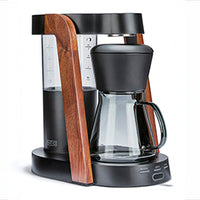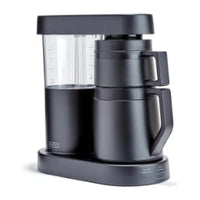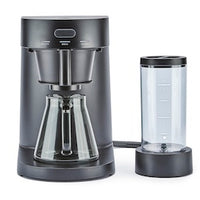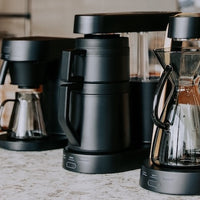You Don’t Need a Fancy Grinder, You Need a Consistent One
Key Takeaways
-
Grind consistency impacts extraction more than grinder brand or price tag
-
Uneven grind leads to both over- and under-extraction in a single cup
-
Burr grinders offer better particle uniformity than blade grinders
-
Focus on repeatability and consistency over premium features
-
Great coffee starts with a reliable grind, not necessarily an expensive one
In the world of home coffee brewing, it’s easy to get caught up in gear envy. That sleek, high-end grinder with 40 settings and a digital timer? It looks impressive. But if it doesn’t grind consistently, all those features are just expensive distractions.
The truth is, you don’t need a fancy grinder. You need a consistent one.
Why Consistency Matters More Than Price
Coffee extraction is all about how evenly water pulls flavor from your grounds. If your grind size varies wildly, you’re asking hot water to extract from fine powder and chunky boulders at the same time.
The result?
-
Fines over-extract: bitter, dry flavors
-
Chunks under-extract: sour, flat notes
-
A brew that’s imbalanced, murky, and hard to troubleshoot
Even with great beans, filtered water, and a quality brewer, inconsistent grind will sabotage your cup.
Consistent grinding helps the water draw out soluble compounds more evenly, unlocking clarity, body, and the subtle tasting notes your beans have to offer. This becomes especially crucial for more complex coffees — where you’re aiming to preserve delicate citrus, floral, or nutty flavors.
Blade vs Burr: The Real Difference
Blade grinders chop beans unevenly with spinning metal blades. Burr grinders crush them between two surfaces, resulting in more uniform particles.
Why burr grinders win:
-
Consistent grind size = consistent extraction
-
Less heat during grinding = better flavor retention
-
Adjustable settings for different brew methods
-
Reduced dust and fines, which affect taste and clarity
You don’t need a $500 burr grinder. But you do need one that produces repeatable results.
A blade grinder may seem economical at first, but its uneven performance creates flavor imbalances that are nearly impossible to fix with technique alone. Over time, a modest burr grinder will more than pay for itself in quality.
What to Look for in a Reliable Grinder
Skip the bells and whistles. Instead, focus on these practical features:
-
Stable burr alignment to ensure uniform grinding
-
Grind size adjustment that stays locked and doesn't drift over time
-
Low grind retention (less leftover grounds inside) for better freshness
-
Ease of cleaning and maintenance
Even seemingly minor design details — like how the grounds fall into the container or how easily static builds up — can affect your day-to-day experience.
A decent hand grinder with steel burrs often outperforms budget electric models. It’s not about automation — it’s about consistency.

Common Mistakes That Undermine Consistency
Even with a solid grinder, your process matters. Avoid these pitfalls:
-
Changing grind settings mid-brew — this introduces variables you can’t control
-
Grinding stale beans — old beans break inconsistently and clump up
-
Not cleaning burrs regularly — buildup affects performance and flavor
-
Eyeballing your dose instead of weighing — even great grinders can’t compensate for poor ratios
Consistency is about more than the grinder — it’s about your entire workflow. Treat your tools with the same care you give your beans.
How Inconsistency Affects Different Brew Methods
Every brew method has a grind size sweet spot. Inconsistency affects them all differently:
-
Pour-over: leads to channeling and weak cups
-
French press: results in sludge and bitterness
-
Espresso: throws off pressure and flow, causing sourness or harshness
-
Cold brew: uneven flavor, sediment buildup
With pour-over, for instance, inconsistent grind size causes water to pass too quickly through coarse pieces while stalling over fines — creating a disjointed cup. Espresso, with its need for high-pressure precision, becomes a gamble without a precise grind.
When you get consistent, your brew method becomes easier to dial in. Recipes make sense. Taste becomes more predictable.
Don’t Chase Expensive. Chase Reliable.
A consistent grinder helps you:
-
Brew better coffee with less guesswork
-
Taste your beans the way they were meant to be
-
Identify and fix issues without changing too many variables
It also removes one of the biggest obstacles to improving your brewing skills: inconsistency. With a reliable grinder, you’re not fighting against your gear — you're working with it.
Spending less on a good grinder and more on high-quality, fresh beans is often a smarter move than maxing out your budget on flashy equipment.
Why Repeatability Is More Important Than Range
Some grinders boast dozens of grind settings. But if those settings shift unpredictably, or if your grind fluctuates from one use to the next, what’s the point?
Repeatability — the ability to get the same grind size every time — is more valuable than flexibility. One good setting you can count on is better than 40 that you can’t.
Dialing in your brew should become second nature, not a daily battle.
Simplicity That Works
Coffee machines like those from Ratio Coffee are designed to simplify the brewing process while delivering precision. The same logic applies to grinders: consistency and simplicity are worth more than complexity.
You don’t need your grinder to talk to your phone or remember a profile — you need it to do its one job well: grind coffee evenly. Everything else is optional.
Pair a consistent grind with a machine that handles temperature and timing, and you’ve set yourself up for reliably excellent coffee — no drama, no overthinking.
Calibrating Your Grinder for Success
If you’re not sure whether your grinder is delivering consistent results, try this simple calibration method:
-
Grind a small batch and spread the grounds on a white sheet of paper
-
Observe the size variation — look for fines (dust) and boulders (chunks)
-
Make small adjustments and repeat until the grind size looks uniform
Consistency here is visual and tactile. Over time, you’ll start to spot unevenness by eye and improve your ability to dial in.
Invest in Consistency, Not Complexity
There’s a lot of noise in the home coffee gear market — new gadgets, luxury features, and clever marketing. But none of it matters if your grind isn’t consistent.
Start with this principle: control what you can repeat. Once your grind is stable, the rest of your coffee journey becomes smoother, tastier, and far more enjoyable.
Frequently Asked Questions
Do I need a burr grinder for good coffee?
Yes. Burr grinders are essential for consistency. Blade grinders create uneven particles that lead to unpredictable flavor.
Are hand grinders good enough?
Absolutely. Many affordable hand grinders with steel burrs outperform entry-level electric grinders in consistency.
How often should I clean my grinder?
Every 1–2 weeks for home use, or after every bag of beans. Coffee oils and grounds can build up fast.
What grind setting should I use?
It depends on your brew method. Start with the recommended range and adjust based on taste — coarser for longer brews, finer for faster ones.
 Ratio Eight S2
Ratio Eight S2
 Ratio Eight Original
Ratio Eight Original
 Ratio Six
Ratio Six
 Ratio Four
Ratio Four
 Compare Machines
Compare Machines






